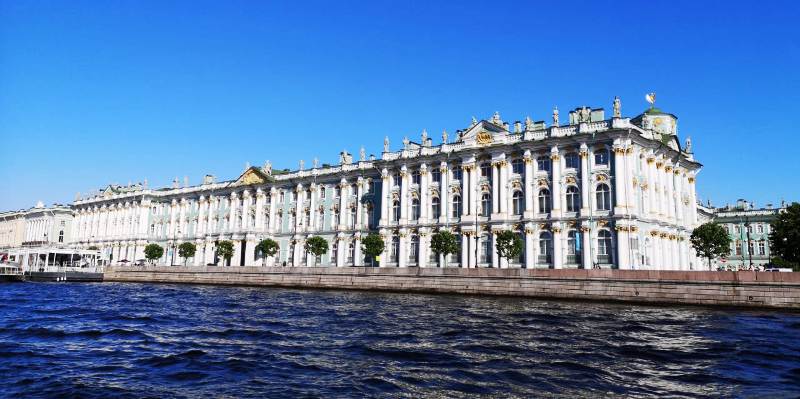Main page Tours and offers Visa-free tours About Saint-Petersburg Contacts
N.B. Please find actual information about my tours on my new web-site Your guide in St Petersburg!
The Hermitage Museum
The Hermitage Museum, the greatest museum in Russia, is one of the most wonderful and beloved sights for the residents and the guests of the city.
N.B. Please find actual information about my tours on my new web-site Your guide in St Petersburg!
The Hermitage Museum ranks with such world famous museums as the British Museum, the National Gallery (London, Great Britain), the Louvre (Paris, France), the Metropolitan Gallery (New York, the USA) and the Prado (Madrid, Spain).
The Hermitage Museum is one of the largest museums in the world. Its expositions take 400 halls and are situated in four museum buildings which - together with the Hermitage Theatre - form one of the most brilliant architectural ensembles in the central part of Saint-Petersburg.

The complex of 5 buildings was being built during the century: from the 2nd half of the 18th century until the middle of the 19th century.
Five buildings of the Museum Complex:
- The Winter Palace (the middle of the 18th century, Rastrelli)
- The Small Hermitage (the 2nd part of the 18th century, Felten, la Moth)
- The Old Hermitage (the 2nd half of the 18th century, Felten)
- The Theatre (the end of the 18th century, Quarenghi)
- The New Hermitage (the beginning of the 19th century, von Klenze).
The Hermitage Museum is unique as the interior and takes the 4th place in the worldin the number of items.
Today there are nearly 3 million of them, including:
- more than 16000 of paintings;
- about 12000 of sculptures;
- about 630000 of engravings and drawings;
- more than 700000 of archeology items;
- about 273000 of applied art items;
- more than 1000000 coins and medals.
The Collections of works of art, gathered together and displayed in the Museum, are widely famous around the world.
The Collections of the Hermitage Museum are divided into 6 departments:
1. Depart of West-European Art - the oldest and the biggest one;
2.The Antiquities Department (Art of Ancient Greece and Rome);
3.Department of History of Primitive Culture;
4.Oriental Department;
5.Department of History of Russian Culture;
6.The Numismatic Department.
In general, the Hermitage Collection was started by Peter the Great himself. The tsar collected art and his collection (especially from Siberia) was transferred into the Museum. It was in the 19th century. It was the collection of goldware from burial mounds.
Peter I also collected sculptures and the most available from them are from Venice (Italy) and Taurida (Spain). All of then were located in the Summer Garden, but in 1777, when a great flood destroyed the fountains and sculptural group of the Summer Garden, the most of them were placed in the Hermitage Museum.
Peter I showed great interest in art and participated in auction sales. The first painting he bought for his private museum was a canvas by Rembrandt "David and Jonaphan", it was the first painting by a great Dutch master came to Russia.
Nevertheless, the birth of the Museum is linked with the name of Catherine the Great. In 1764 she purchased a collection of paintings from a Prussian merchant Gotskovskey: 225 works, created by Dutch and Flemish masters. After Catherine II founded the museum one purchase followed another: in the second half of the 18th century there was enough money at court to buy great collections from Western Europe. The clever diplomacy of Catherine II helped gathering of art items and raised the authority of Russia.
To the end of the 18th century in the Hermitage Museum there was a great collection of Dutch and Flemish art items: it was the beginning of forming Italian Collection (16th - 17th centuries) and French Collection (17th - 18th centuries). Also Spanish, German, English schools were presented with several items.
From the beginning of the 19th century very slowly Hermitage started to gain experience as a real museum. Several apartments were organized and they were ruled by curators. But it still was a museum at court, not a public museum.
The most famous museums in the world (Louvre, Drezden Gallery, Prado, London National Gallery) were opened for the public in the middle of the 19th century. So it was obviously to reorganize the Hermitage as a museum and in 1852 it began to function as a public museum.
At the beginning of the 20th century the Collection was considerably enriched. After the revolution of 1917 many private collections were nationalized. For example, the rich collections of Impressionism, owned by Morozov and Schukin laid a basement of the Hermitage's collection of French Art of the 19th - 20th centuries.





